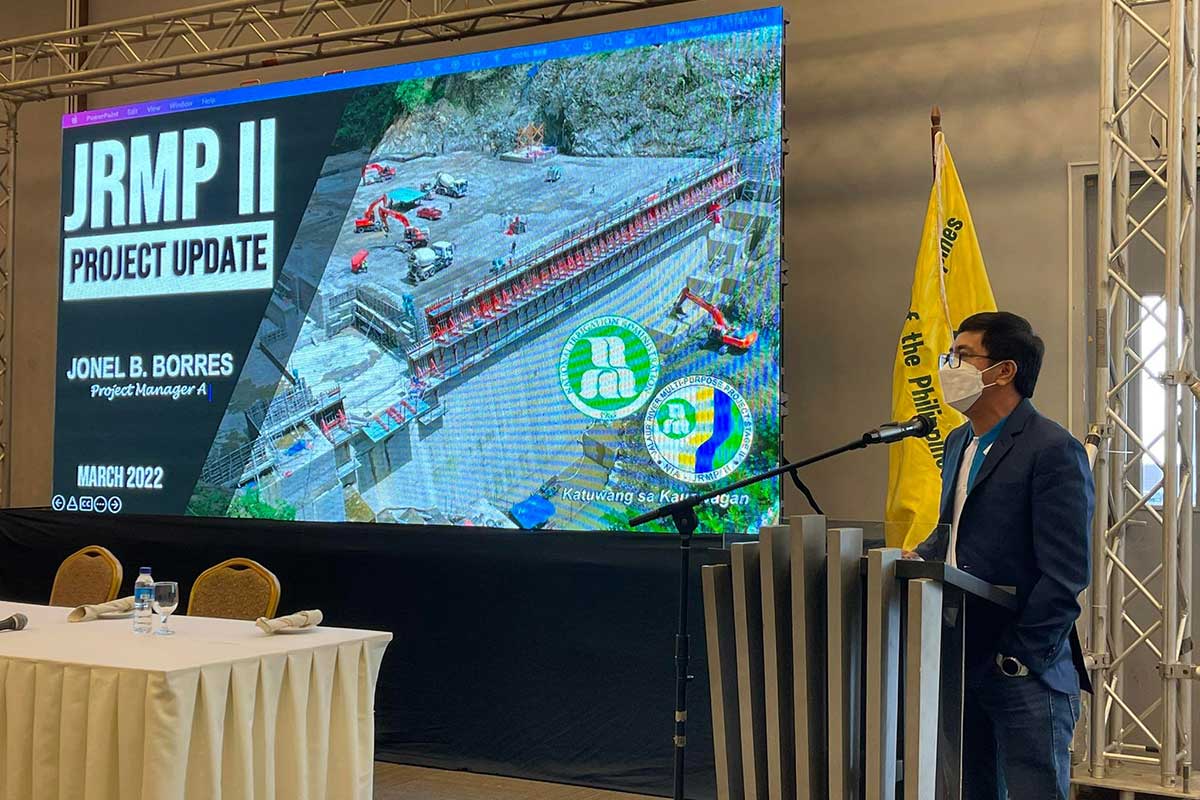
By Jennifer P. Rendon
Barring any unforeseen circumstances, the P11.2-billion Jalaur River Multi-Purpose Project Stage II (JRMP II), the largest megadam project outside Luzon, will be completed on schedule.
The National Irrigation Administration (NIA) in Region 6, the lead implementing agency of the project, announced in a press conference Monday that JRMP II is still on schedule with an overall physical accomplishment of 48.37 percent as of March 2022.
The JRMP will have all its civil works completed by Dec. 29, 2023, project manager Engineer Jonel Borres said.
Despite the pandemic, Borres said the implementation of Iloilo’s biggest irrigation development project continues.
“Hopes are high that we could finish the construction as scheduled,” he said.
Borres presented the highlights of the period’s accomplishments, including the ongoing construction of the Jalaur High Dam, the reservoir dam of the project.
Joining Borres was Senator Franklin Drilon, the main proponent of the project.
As of this writing, the construction of the Jalaur High Dam has already reached 33.1 meters high out of its 109 meters structural height.
NIA and Daewoo Engineering and Construction (DEC) commenced the construction of the high dam, specifically the placement of its concrete body, in June 2021.
The tallest of the three dams, the High Dam will store an estimated of 250.70 million cubic meters of water that will be utilized for irrigation, hydropower, bulk water, inland fishery, and eco-tourism purposes.
Meanwhile, construction of the downstream coffer dam at the 38.5-meter Jalaur Afterbay Dam, which is the regulating dam, is also ongoing.
The construction of the Afterbay Dam is already at 17 meters high out of the 38.5-meter structural height.
The construction of High Dam and Afterbay Dams are the first time for NIA to use the Roller Compacted Concrete (RCC) method in dam construction.
The RCC method is a modern technology adopted worldwide as alternative to conventional concrete due to its economic value, high performance, and high speed of construction.
Furthermore, simultaneous to the construction of the dams is the implementation of the irrigation component of the project which includes the High Line Canal and the Main and Lateral Canals of the project.
The construction of the 80.736 kilometers long High Line Canal, the main conveyance structure of JRMP II, and the 80-kilometer main and lateral canals, are all together done in the municipalities of Calinog, Lambunao, Janiuay and Cabatuan.
Meanwhile, Borres has again called for support, as the project is now a year away from completion.
NIA Administrator Ricardo Visaya has also given assurance to all stakeholders that the project will be completed as planned amidst the pandemic.
BENEFITS
Branded as “Partner in Progress,” JRMP II is a much-deserved and much-needed development for every Ilonggo family.
Drilon said that once operational, the dam could benefit 25,000 farmer families in the 24 municipalities and lone component city in Iloilo province.
The senator also attributed the Jalaur dam as the reason why Typhoon Agaton did not affect the towns surrounding the project.
“There’s no more flooding because the dam utilizes water from inclement weather,” he said.
On top of flood mitigation, Drilon said that the JRMP II has been a source of employment opportunities.
With the JRMP II, the service area for irrigation would be increased from 22,340 hectares to 31,840 hectares.
“Further, we could see a boost in rice production from 140,000 to 300,000 metric tons per year,” he said.
Aside from the bulk water supply, NIA has earlier stated that the JRMP II would be used for hydroelectric power supply.
There are also plans to develop eco-cultural tourism opportunities around the megadam.
JRMP II in Calinog, Iloilo broke ground on Feb. 27, 2019.
The activity officially marked the official start of the implementation of the JRMP II, which is dubbed as an “important economic game-changer” for Iloilo province.
The JRMP II is envisioned to usher inclusive rural growth through year-round irrigation coupled with Institutional Development and Environmental Management.
The primary areas that will be serviced by the project include the towns of Calinog, Lambunao, Badiangan, Janiuay, Cabatuan, Sta. Barbara, Pavia, Alimodian, Leon, San Miguel, Oton, Tigbauan, Dueñas, San Enrique, Anilao, Dingle, Barotac Nuevo, Dumangas, Mina, New Lucena, Pototan, Zarraga, and Leganes and Passi City, and Iloilo City.
The South Korean government, through the Export-Import Bank’s Economic Development Cooperarion, extended a $208-million loan under its Official Development Assistance program.
The loan agreement was signed in 2012. The Philippine government’s counterpart funding is P2.2 billion.
The JRMP came into being in June 1960 under Republic Act 2651. Stage 1 involves the rehabilitation of irrigation system covering an area of 22,340 hectares.
Stage II involves the construction of a large-scale reservoir dam to provide uninterrupted irrigation water supply to 31,840 hectares of farmland.
Stage 1 was completed in July 1982.
The project was then stalled until the conduct of a feasibility study in 2009.
JRMP II is the first large-scale reservoir outside of Luzon.
It will include the construction of three dams – a 109-meter high dam, and a 38-meter afterbay dam across the Jalaur River, and a catch dam at the Alibunan River.
An 80-kilometer high line canal will also be constructed to deliver water from the dams to the rice paddies.
























